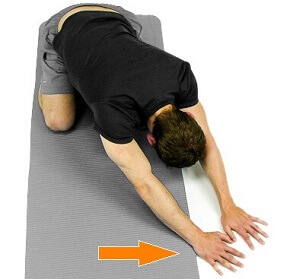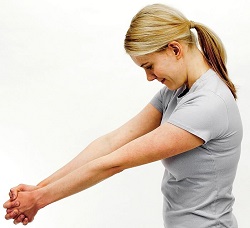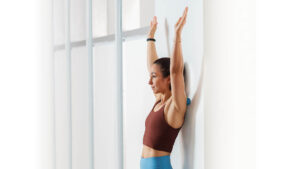

Ever catch yourself hunched over your phone or computer, only to realize your head is jutting forward like a turtle peeking out of its shell?
That awkward, strained position has a name—“nerd neck,” or more formally, forward head posture (FHP). It’s the kind of postural distortion that creeps up quietly, becoming more pronounced with every text, email, and binge-watch session.
Fueled by hours spent in front of screens, FHP is more than just a cosmetic concern—it can lead to chronic neck pain, tension headaches, upper back tightness, and even impaired breathing patterns due to compression of the airway.
The culprit?
Muscular imbalances, especially in the trapezius muscle group, which often tightens and strains under poor postural habits.
But here is the good news: your posture is not set in stone.
With consistent, targeted trapezius stretches, you can begin reversing nerd neck, reducing discomfort, and regaining a more confident, upright posture—no expensive gear required, just daily commitment and a little body awareness.
Points Covered in this Article:
- Understanding Forward Head Posture and the Trapezius Muscle
- The Role of the Trapezius in Posture
- Top 10 Trapezius Stretches to Combat Nerd Neck
- 3.1. Upper Trapezius Stretch
- 3.2. Levator Scapulae Stretch
- 3.3. Corner Stretch
- 3.4. Chin Tucks
- 3.5. Shoulder Blade Squeeze
- 3.6. Wall Angels
- 3.7. Doorway Stretch
- 3.8. Cat-Cow Stretch
- 3.9. Neck Flexor Stretch
- 3.10. Resistance Band Pull-Aparts
- Incorporating Stretches into Daily Routine
- Conclusion
Understanding Forward Head Posture and the Trapezius Muscle
Forward head posture (FHP) occurs when the head shifts ahead of the body’s natural center of gravity, disrupting the alignment of the spine.
This forward drift doesn’t just affect appearance—it significantly increases mechanical strain on the cervical spine and surrounding musculature. Among the most affected is the trapezius, a large, diamond-shaped muscle that plays a pivotal role in upper body posture.
It extends from the base of the skull, runs down the neck and upper back, and fans out across the shoulders.
The trapezius is divided into three functional sections: upper, middle, and lower fibers. Each part contributes to different movements, including shoulder elevation, scapular retraction, and neck extension.
When the head leans forward for prolonged periods, the upper fibers become tight and overactive, while the middle and lower fibers weaken, disrupting muscular balance.
This imbalance leads to stiffness, reduced range of motion, and postural fatigue—making targeted stretching and strengthening of the trapezius essential for reversing FHP.
The Role of the Trapezius in Posture
When the head juts forward—often a result of prolonged screen use or slouched sitting—the biomechanics of the neck and upper back begin to shift in harmful ways.
The upper trapezius, responsible for elevating the shoulders and extending the neck, becomes chronically overactive and tight as it tries to support the forward-leaning head.
Meanwhile, the middle and lower trapezius fibers, which help stabilize and retract the shoulder blades, become underused, weak, and lengthened due to lack of engagement.
This muscular imbalance not only contributes to poor posture but also impairs shoulder function, reduces neck mobility, and increases the risk of tension headaches and chronic myofascial pain.
According to research published in the Journal of Physical Therapy Science, individuals with forward head posture exhibit significantly altered trapezius muscle activation patterns during everyday movements.
Addressing these issues requires a dual approach: releasing tension in the fibers to restore postural integrity and functional balance.
FAQs on Trapezius Stretches to Fix Text Neck
Q-1: Which part of the trapezius should I actually stretch for forward head posture (FHP)?
A-1: Focus on the upper trapezius (UT), which often carries extra tension when the head drifts forward. But don’t stop there: pair UT stretching with activation of the lower trapezius (LT) and deep neck flexors (DCF). Think “release the overactive, recruit the underactive.” That combo helps the head re-stack over the torso instead of snapping back into a shrug.
Q-2: What’s a UT stretch that targets the right tissue without cranking my neck?
A-2: Sit tall. Hold the chair seat with your right hand to keep the shoulder down. Gently side-bend your head left, then add a tiny right rotation (this biases UT more than levator scapulae). Exhale and hold 20–30 seconds, 2–3 reps per side. Optional: light fingertip contact near the temple to cue direction—not to press hard. If your shoulder hikes, reset and grip the seat again.
Q-3: How much and how often should I stretch to change posture versus just feel looser?
A-3: Use daily micro-doses plus three focused sessions per week. Micro-dose example: 2–3 quick holds per side sprinkled through the day (about 1–2 total minutes/side). Focused session: UT stretch 3×30 s/side, then LT work (wall slides or low rows) and DCF nods (tiny “yes” nods with the skull gliding, not lifting). Stretch opens the door; LT/DCF keep it from slamming shut.
Q-4: How do I know the UT stretch is helping my forward head and not just flexibility?
A-4: Track three simple markers for two weeks:
A quick side photo to gauge ear-over-shoulder or craniovertebral angle.
A head-turn task (how far you can read a side monitor before your shoulders follow).
End-of-day neck fatigue on a 0–10 scale.
If the photo shows a more stacked head, you scan side content with eyes before shoulders, and evening fatigue drops, your routine is changing posture, not just tissue feel.
Q-5: What if my UT always “rebounds” tight later in the day?
A-5: Add context and antagonists after every stretch. Do one set of LT/serratus work (e.g., wall slides, low-angle rows) and DCF nods, then fix the environment: screens at eye level, keyboard close, and a sticky note that reads “Crown tall.” The environment holds your gains when attention drifts. Bonus: schedule a 30–60 second stretch + activation mini-cycle every 60–90 minutes during desk work to prevent the rebound altogether.
Bottom line: Precise UT stretching is the entry point; consistency plus LT/DCF activation and small ergonomic tweaks are what transform a momentary release into a lasting shift away from forward head posture.
Top 10 Trapezius Stretches to Combat Nerd Neck
Let me walk you through the top 10 stretching techniques that shall ensure that your traps shall become flexible enough to naturally fix your text neck:
Upper Trapezius Stretch
- How to: Sit or stand upright. Gently tilt your head to one side, bringing your ear toward your shoulder. Use your hand to apply slight pressure for a deeper stretch. Hold for 20-30 seconds and repeat on the other side.
- Benefit: Relieves tension in the upper trapezius, reducing neck and shoulder discomfort.
Levator Scapulae Stretch
- How to: Sit upright and rotate your head 45 degrees to one side. Tilt your chin down toward your armpit. Use your hand to gently deepen the stretch. Hold for 20-30 seconds and switch sides.
- Benefit: Targets the levator scapulae, which often becomes tight with FHP.
Corner Stretch
- How to: Stand facing a corner with your forearms on each wall at shoulder height. Lean in until you feel a stretch in your chest and shoulders. Hold for 30 seconds.
- Benefit: Opens up the chest, counteracting the forward pull on the shoulders.
Chin Tucks
- How to: Sit or stand with your spine straight. Gently draw your chin back, creating a “double chin” without tilting your head. Hold for 5 seconds and repeat 10 times.
- Benefit: Chin Tucks strengthens deep neck flexors and realigns head posture.
Shoulder Blade Squeeze
- How to: Sit or stand upright. Squeeze your shoulder blades together, hold for 5 seconds, and release. Repeat 10 times.
- Benefit: Strengthens the middle trapezius, promoting better posture.
Wall Angels
- How to: Stand with your back against a wall, arms at 90 degrees. Slowly raise and lower your arms, keeping them and your back against the wall. Repeat 10 times.
- Benefit: Enhances mobility and strengthens upper back muscles.
Doorway Stretch
- How to: Place your arms on either side of a doorway at shoulder height. Step forward until you feel a stretch in your chest. Hold for 30 seconds.
- Benefit: Stretches the pectoral muscles, which can pull the shoulders forward.
Cat-Cow Stretch
- How to: On all fours, alternate between arching your back (cow) and rounding it (cat). Move slowly and breathe deeply. Repeat 10 times.
- Benefit: Cat Cow Stretch Improves spinal flexibility and posture awareness.
Neck Flexor Stretch
- How to: Lie on your back with knees bent. Gently nod your head, bringing your chin toward your chest. Hold for 5 seconds and repeat 10 times.
- Benefit: Strengthens deep neck flexors, supporting head alignment.
Resistance Band Pull-Aparts
- How to: Hold a resistance band with both hands at shoulder height. Pull the band apart, squeezing your shoulder blades together. Return slowly. Repeat 10 times.
- Benefit: Resistance band stretches strengthens the upper back, combating rounded shoulders.
Incorporating Stretches into Daily Routine
Consistency is the cornerstone of lasting postural change. While a single stretching session may offer temporary relief, true correction of forward head posture requires daily, deliberate practice.
If you spend long hours sitting at a desk, scrolling on your phone, or working on a computer, your muscles are continuously adapting to that slouched, head-forward position.
According to bestforwardheadposturefix experts, “Performing trapezius stretches just once in a while won’t undo the cumulative strain”. Instead, aim to integrate these movements into your daily routine—whether it is first thing in the morning to wake up stiff muscles, during mid-day breaks to reset your posture, or in the evening as part of a wind-down ritual.
You do not need a gym, special equipment, or even a large space—just a few minutes and your own awareness.
Over time, these small, consistent efforts add up. You shall notice improved posture, reduced tension, and greater comfort in your neck and shoulders. Think of it as daily maintenance for your musculoskeletal health.
Conclusion
Forward head posture—affectionately dubbed “nerd neck”—might be the unofficial badge of honor for the tech-savvy generation, but let’s be honest: it is a pain in the neck… literally.
The good news?
You do not have to live life craning forward like a curious goose. With a bit of anatomical know-how and a daily dose of trapezius TLC, you can start reclaiming your upright dignity.
Stretching the overworked upper traps and activating the sleepy lower fibers is like hitting the reset button on your posture.
Think of it as sending a gentle eviction notice to bad habits and inviting graceful alignment back in.
And no, you won’t need fancy gadgets or a chiropractor on speed dial—just a willingness to show up each day with a neck-saving stretch and a smirk of determination.
So roll out your mat, straighten that spine, and remember: good posture isn’t just about looking taller—it is about feeling stronger, lighter, and wonderfully pain-free.
References:

